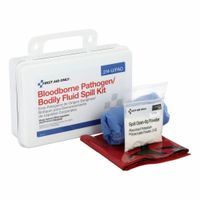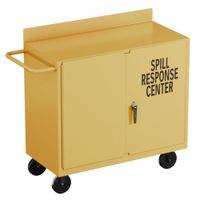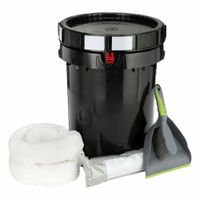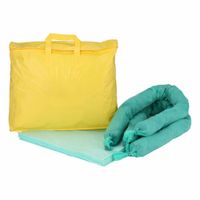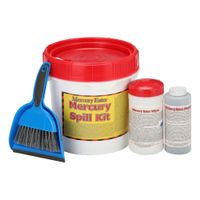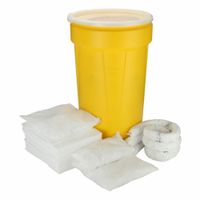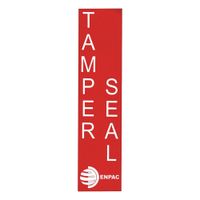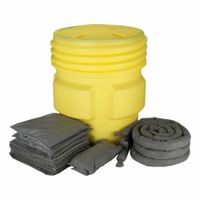Call +(254) 703 030 000 / 751 483 999 / 721 704 777
- Home
- Safety
- Sorbents Spill Control Spill Containment
- Sorbents Spill Kits
.....Read More
Frequently Asked Questions
What are sorbents and spill kits used for?
Sorbents and spill kits are essential tools used for managing and mitigating spills of hazardous and non-hazardous materials.
Sorbents are materials designed to absorb or adsorb liquids, including oils, chemicals, and water. They come in various forms such as pads, rolls, pillows, socks, and loose particulate. Sorbents are categorized based on their application: oil-only sorbents are hydrophobic and used for oil spills on water, while universal sorbents can absorb a variety of liquids, including water-based chemicals. Chemical sorbents are specifically designed to handle aggressive fluids like acids and bases.
Spill kits are comprehensive packages that contain a variety of tools and materials to effectively respond to spills. They typically include sorbents, personal protective equipment (PPE) like gloves and goggles, disposal bags, and instructions for use. Spill kits are tailored to specific types of spills, such as oil, chemical, or universal spills, and are available in different sizes to suit various environments, from small workshops to large industrial sites.
The primary purpose of sorbents and spill kits is to quickly contain and clean up spills to prevent environmental contamination, protect human health, and ensure workplace safety. They help in minimizing the spread of hazardous substances, reducing the risk of slips and falls, and ensuring compliance with environmental regulations. Proper use of these tools is crucial in emergency response plans, enabling rapid and efficient spill management to mitigate potential damage and liability.
How do universal sorbents differ from oil-only sorbents?
Universal sorbents and oil-only sorbents are both used for spill control, but they differ in their composition and application.
Universal sorbents are designed to absorb a wide range of liquids, including water-based fluids, oils, coolants, solvents, and other chemicals. They are typically made from polypropylene or cellulose materials that are treated to enhance their absorbency. Universal sorbents are versatile and can be used in various environments, making them suitable for industries where multiple types of liquids might be spilled. They are often used in manufacturing plants, laboratories, and workshops where diverse liquid spills can occur.
Oil-only sorbents, on the other hand, are specifically engineered to absorb oil and other hydrocarbon-based liquids while repelling water. This makes them ideal for use in marine environments, such as on water bodies, where oil spills need to be contained and cleaned up without absorbing water. Oil-only sorbents are also made from polypropylene but are treated to ensure they do not absorb water. They are commonly used in industries like oil and gas, shipping, and transportation, where oil spills are a primary concern.
In summary, the key difference lies in their absorbency capabilities: universal sorbents can handle a variety of liquids, while oil-only sorbents are specialized for oil and hydrocarbon spills, repelling water. This distinction determines their application in different spill scenarios.
What types of spills can fuel and flammable liquid sorbents handle?
Fuel and flammable liquid sorbents are designed to handle a variety of spills involving hydrocarbons and other flammable substances. These sorbents are typically used for:
1. **Petroleum-Based Liquids**: They can absorb spills from gasoline, diesel, kerosene, and other petroleum-based fuels. This includes both light and heavy oils.
2. **Crude Oil**: Sorbents are effective in managing spills of crude oil, whether on land or water, helping to mitigate environmental damage.
3. **Lubricating Oils**: They can absorb motor oils, hydraulic oils, and other lubricants that may leak from machinery or vehicles.
4. **Solvents**: Many sorbents can handle spills of organic solvents such as acetone, toluene, and xylene, which are often used in industrial and laboratory settings.
5. **Paints and Thinners**: They can absorb spills from oil-based paints and paint thinners, which are flammable and potentially hazardous.
6. **Jet Fuels**: Sorbents are suitable for aviation fuel spills, including Jet A and Jet B fuels, which require rapid response due to their volatility.
7. **Heating Oils**: They can manage spills from heating oils used in residential and commercial heating systems.
8. **Marine Fuels**: Sorbents are used in maritime environments to address spills of bunker fuel and other marine fuels.
These sorbents are typically made from materials like polypropylene, which is oleophilic (oil-attracting) and hydrophobic (water-repelling), allowing them to selectively absorb oil while repelling water. This makes them particularly useful in marine environments where oil spills need to be contained and cleaned up without absorbing large amounts of water.
How do harsh chemical sorbents work with strong chemicals?
Harsh chemical sorbents work with strong chemicals through a process of adsorption or absorption, depending on the type of sorbent material used. These sorbents are designed to capture and contain hazardous chemicals, preventing them from spreading and causing environmental or health hazards.
1. **Adsorption**: In this process, the sorbent material attracts and holds the chemical molecules on its surface. This is typically achieved through physical forces such as van der Waals forces or chemical bonding. Activated carbon is a common adsorbent that works well with organic chemicals due to its high surface area and porous structure.
2. **Absorption**: This involves the uptake of chemicals into the internal structure of the sorbent material. Absorbents swell as they take in the liquid, effectively containing the chemical within their matrix. Polymeric materials, such as superabsorbent polymers, are often used for this purpose.
3. **Chemical Interaction**: Some sorbents are designed to chemically react with the hazardous substance, neutralizing it or transforming it into a less harmful compound. This is common in sorbents used for acid or base spills, where neutralization is necessary.
4. **Material Selection**: The choice of sorbent material depends on the chemical properties of the substance being contained. For instance, inorganic sorbents like clay or vermiculite are often used for oil spills, while synthetic polymers might be chosen for their compatibility with specific industrial chemicals.
5. **Efficiency and Safety**: The effectiveness of a sorbent is determined by its capacity, rate of uptake, and compatibility with the chemical. Safety considerations include ensuring that the sorbent does not react dangerously with the chemical or release harmful byproducts.
Overall, harsh chemical sorbents are crucial in managing chemical spills, protecting the environment, and ensuring workplace safety by effectively containing and neutralizing strong chemicals.
What is included in a biohazardous liquid and bodily fluid spill kit?
A biohazardous liquid and bodily fluid spill kit typically includes the following components:
1. **Personal Protective Equipment (PPE):**
- Gloves: Usually nitrile or latex, to protect hands from contamination.
- Gown or Apron: To protect clothing and skin.
- Face Mask: To prevent inhalation of aerosols.
- Eye Protection: Goggles or face shield to protect eyes from splashes.
2. **Absorbent Materials:**
- Absorbent Pads or Granules: To soak up liquids quickly.
- Solidifier: A powder that turns liquids into a gel for easier cleanup.
3. **Cleaning and Disinfecting Agents:**
- Disinfectant Wipes or Sprays: To sanitize the area after the spill is absorbed.
- Biohazard Disposal Bags: For safe disposal of contaminated materials.
4. **Tools for Cleanup:**
- Scoop and Scraper: To pick up solidified materials.
- Tongs or Forceps: For handling contaminated items without direct contact.
5. **Instructions and Documentation:**
- Step-by-Step Instructions: For proper use of the kit.
- Incident Report Form: To document the spill and cleanup process.
6. **Additional Items:**
- Hand Sanitizer: For use after removing gloves.
- Labels: To mark the biohazard waste for disposal.
These components are designed to ensure safe and effective cleanup of biohazardous spills, protecting both the individual handling the spill and the surrounding environment.
How do mercury sorbents safely contain mercury spills?
Mercury sorbents safely contain mercury spills by utilizing materials that can effectively adsorb or chemically bind with mercury, preventing its vaporization and spread. These sorbents are typically composed of materials like activated carbon, sulfur-impregnated compounds, or proprietary blends designed to target mercury.
When a mercury spill occurs, the sorbent is applied directly to the spill area. The sorbent's high surface area and chemical properties allow it to capture mercury droplets and vapors. Activated carbon, for instance, adsorbs mercury through physical attraction and van der Waals forces, while sulfur-impregnated sorbents chemically react with mercury to form mercuric sulfide, a stable compound that reduces the risk of mercury vapor release.
The effectiveness of mercury sorbents is enhanced by their ability to work at room temperature and their non-toxic nature, making them safe for use in various environments. Once the mercury is contained, the sorbent material can be safely collected and disposed of according to hazardous waste regulations, minimizing environmental and health risks.
Additionally, some advanced sorbents incorporate nanotechnology or specialized polymers to increase their mercury-binding efficiency. These materials can capture even trace amounts of mercury, ensuring thorough decontamination of the affected area.
Overall, mercury sorbents provide a practical and efficient solution for managing mercury spills, protecting both human health and the environment from the toxic effects of mercury exposure.
What accessories are available for storing and using sorbents and spill kits?
Accessories for storing and using sorbents and spill kits include:
1. **Spill Kit Cabinets and Stations**: These are wall-mounted or free-standing units designed to store spill kits in accessible locations. They often have clear labeling and instructions for quick identification and use.
2. **Spill Kit Bags and Containers**: Portable bags, buckets, or wheeled containers that house sorbents and spill response tools, allowing for easy transport to spill sites.
3. **Sorbent Dispensers**: Wall-mounted or free-standing dispensers that allow for easy access to sorbent pads, rolls, or socks. They help in maintaining organization and quick deployment.
4. **Drum Storage Units**: Specialized containment units for storing sorbent materials in drums, ensuring they are kept dry and ready for use.
5. **Pallets and Racks**: Used for organizing and storing larger quantities of sorbents, these can be designed to hold boxes, bags, or rolls of sorbent materials.
6. **Labeling and Signage**: Clear labels and signs for spill kit locations and contents, ensuring quick identification and compliance with safety regulations.
7. **Personal Protective Equipment (PPE) Storage**: Cabinets or compartments within spill kits for storing gloves, goggles, and other PPE necessary for safe spill response.
8. **Waste Disposal Bags and Containers**: Included in spill kits for the safe disposal of used sorbents and contaminated materials.
9. **Instructional Guides and Training Materials**: Manuals, guides, or digital resources included with spill kits to provide instructions on proper use and handling.
10. **Absorbent Mats and Grates**: Placed in high-risk areas to prevent spills from spreading and to provide a non-slip surface.
These accessories ensure that sorbents and spill kits are stored efficiently, easily accessible, and ready for immediate use in case of a spill.
